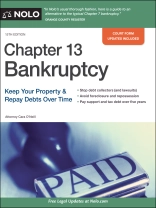Stop creditors. Get more time to pay.
Chapter 13 bankruptcy offers unique debt solutions not available in Chapter 7 bankruptcy. Yes, you’ll pay into a repayment plan. But your money will go toward the debts that matter most—like your mortgage, car loan, support obligations, and taxes. Remaining debts, such as credit card balances, medical bills, and utility bills, usually get only a fraction of what you owe.
Some of Chapter 13 bankruptcy’s other features include allowing filers to:
- keep all property
- avoid foreclosure and vehicle repossession
- pay the fair market value for a car, and
- stop lawsuits, wage garnishments, and bank levies.
Here, you’ll find clear explanations of the Chapter 13 process to help you:
- decide if Chapter 13 is your best option
- estimate your monthly plan payment, and
- find and work effectively with the right lawyer.
This revised edition covers all the latest changes in bankruptcy law, including updated exemption tables for every state, and explains how to use the new official bankruptcy forms.
Inhaltsverzeichnis
Part 1: Is Chapter 13 Right for You? 1.How Chapter 13 Works 2.The Automatic Stay 3. Are You Eligible to Use Chapter 13? 4. Do You Have to Use Chapter 13? 5. Can You Propose a Plan the Judge Will Approve? 6. Making the Decision Part II: Filing for Chapter 13 Bankruptcy 7. Complete Your Bankruptcy Forms 8. The Chapter 13 Plan 9. Filing the Bankruptcy Case 10. Handling Routine Matters After You File Part III: Making Your Plan Work 11. Common Legal Issues 12. Carrying Out Your Plan 13. If You Cannot Complete Your Plan 14. Life After Bankruptcy Part IV: Help Beyond the Book 15. Hiring and Working With a Lawyer 16. Legal Research Glossary Appendixes A: State and Federal Exemption Charts B: Chart and Sample Forms Index
Über den Autor
Cara O’Neill is a bankruptcy and litigation attorney in Northern California and a legal editor and writer with Nolo. Before joining Nolo, she practiced in the areas of criminal and civil litigation, and bankruptcy. She also served as an administrative law judge and taught law courses as an adjunct professor. In 1994, she received her law degree from the University of the Pacific, Mc George School, graduating Order of the Barristers—an honor society recognizing excellence in courtroom advocacy. Cara has edited, authored, and coauthored several Nolo books, including How to File for Chapter 7 Bankruptcy, Chapter 13 Bankruptcy, The New Bankruptcy, Everybody’s Guide to Small Claims Court, and Credit Repair.












